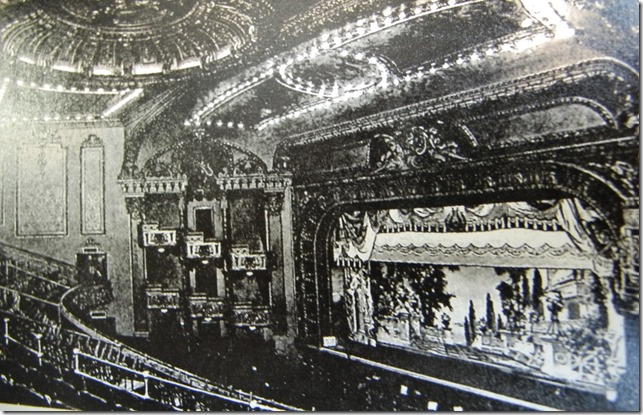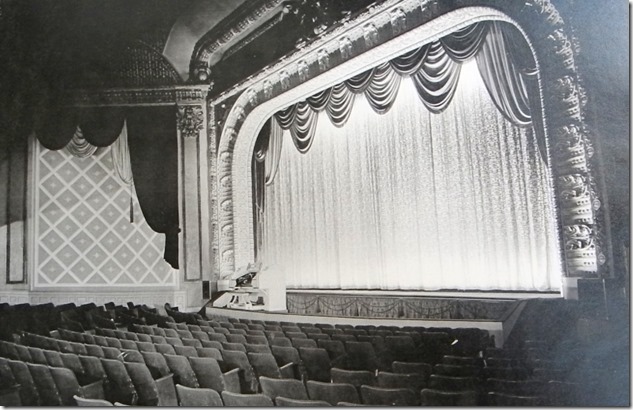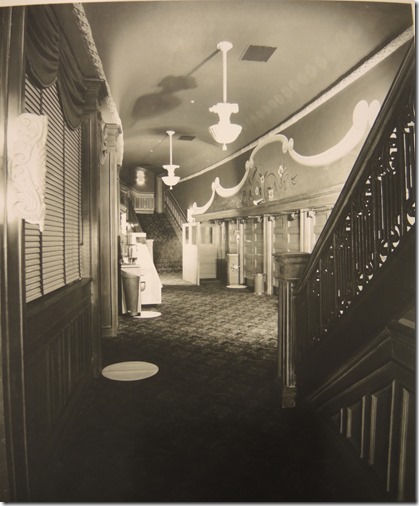` Photo from City of Toronto Archives.
When Shea’s Hippodrome opened in Toronto on April 27, 1914, it was the largest vaudeville theatre in Canada, with a seating capacity of 3000. Within a few years, it was considered among the top four vaudeville houses in all of North America. It was located at “Queen and Teraulay Streets.” Teraulay Street was later renamed Bay Street, connecting it with the section of Bay Street that stretched south from Queen Street to the harbour. Today, Bay Street extends from Davenport Road, south to the harbour. The site of the old theatre is now a part of eastern section of Nathan Phillips Square. The Hydro sub-station on the west side of Bay Street, a short distance south of Dundas Street West is still named the Teraulay Station.
On inauguration day at the Hippodrome, the theatre featured a series of vaudeville acts entitled, “A Night in an English Music Hall,” supplemented with “leading photo plays” (silent films). Music was provided by The Invisible Symphony Orchestra. The theatre’s ad in the Toronto Star proclaimed, “Nothing cheap but the prices.” The matinee tickets were 10 and 15 cents and in the evening they were 10, 15 and 25 cents. There were continuous performances from 12 noon to 11 pm, with three shows daily.
In 1922, a Wurlitzer organ was installed, which had been built in Tonawanda New York at a cost of $55,000. When the Hippodrome was demolished in 1957, the organ was sold to Maple Leaf Gardens for the price of $2000. The first time the organ was played in The Gardens was on December 20, 1958. When I was a teenager, the great organ was considered an integral part of the hockey games televised by the CBC on “Hockey Night in Canada,” the program sponsored by Imperial Oil.
In 1963, the instrument was bought by the Toronto Theatre Organ Society for $3,800 and placed in storage in the Imperial Theatre on Yonge Street. In 1970 it was relocated to Casa Loma. The first concert in the grand hall of the castle was on February 12, 1974. Visitors today are able to see the organ, located in an alcove in the south wall of the Grand Hall.
Note : information about the Wurlitzer organ was obtained from Mike Filey’s “Toronto Sketches.”
View of the Hippodrome’s auditorium from the balcony. This photo was taken shortly after the theatre opened in 1914.
The auditorium of the Hippodrome, the Wurlitzer organ on the left-hand side of the stage. This photo was likely taken in the 1950s, after the auditorium had been renovated. The box seats on either side of the stage had been removed as the theatre was now exclusively a movie house.
Lobby of the Hippodrome and stairs to the balcony.
To view the Home Page for this blog: https://tayloronhistory.com/
To view previous blogs about movie houses of Toronto—historic and modern
Recent publication entitled “Toronto’s Theatres and the Golden Age of the Silver Screen,” by the author of this blog. The publication explores 50 of Toronto’s old theatres and contains over 80 archival photographs of the facades, marquees and interiors of the theatres. It relates anecdotes and stories of the author and others who experienced these grand old movie houses.
To place an order for this book:
Book also available in Chapter/Indigo, the Bell Light box Book Store and by phoning University of Toronto, Press Distribution: 416-667-7791
Theatres Included in the Book:
Chapter One – The Early Years—Nickelodeons and the First Theatres in Toronto
Theatorium (Red Mill) Theatre—Toronto’s First Movie Experience and First Permanent Movie Theatre, Auditorium (Avenue, PIckford), Colonial Theatre (the Bay), the Photodome, Revue Theatre, Picture Palace (Royal George), Big Nickel (National, Rio), Madison Theatre (Midtown, Capri, Eden, Bloor Cinema, Bloor Street Hot Docs), Theatre Without a Name (Pastime, Prince Edward, Fox)
Chapter Two – The Great Movie Palaces – The End of the Nickelodeons
Loew’s Yonge Street (Elgin/Winter Garden), Shea’s Hippodrome, The Allen (Tivoli), Pantages (Imperial, Imperial Six, Ed Mirvish), Loew’s Uptown
Chapter Three – Smaller Theatres in the pre-1920s and 1920s
Oakwood, Broadway, Carlton on Parliament Street, Victory on Yonge Street (Embassy, Astor, Showcase, Federal, New Yorker, Panasonic), Allan’s Danforth (Century, Titania, Music Hall), Parkdale, Alhambra (Baronet, Eve), St. Clair, Standard (Strand, Victory, Golden Harvest), Palace, Bedford (Park), Hudson (Mount Pleasant), Belsize (Crest, Regent), Runnymede
Chapter Four – Theatres During the 1930s, the Great Depression
Grant ,Hollywood, Oriole (Cinema, International Cinema), Eglinton, Casino, Radio City, Paramount, Scarboro, Paradise (Eve’s Paradise), State (Bloordale), Colony, Bellevue (Lux, Elektra, Lido), Kingsway, Pylon (Royal, Golden Princess), Metro
Chapter Five – Theatres in the 1940s – The Second World War and the Post-War Years
University, Odeon Fairlawn, Vaughan, Odeon Danforth, Glendale, Odeon Hyland, Nortown, Willow, Downtown, Odeon Carlton, Donlands, Biltmore, Odeon Humber, Town Cinema
Chapter Six – The 1950s Theatres
Savoy (Coronet), Westwood
Chapter Seven – Cineplex and Multi-screen Complexes
Cineplex Eaton Centre, Cineplex Odeon Varsity, Scotiabank Cineplex, Dundas Square Cineplex, The Bell Lightbox (TIFF)




![cid_E474E4F9-11FC-42C9-AAAD-1B66D852[2] cid_E474E4F9-11FC-42C9-AAAD-1B66D852[2]](https://tayloronhistory.com/wp-content/uploads/2014/12/cid_e474e4f9-11fc-42c9-aaad-1b66d8522_thumb2.jpg)

